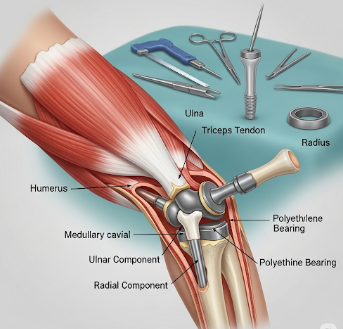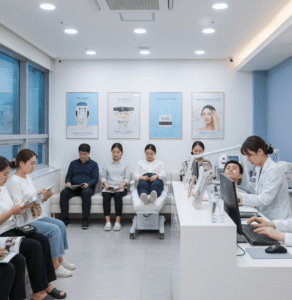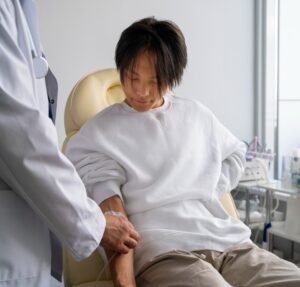Overview
Elbow replacement, also known as total elbow arthroplasty, is a surgical procedure that replaces damaged parts of the elbow joint with artificial components. It is primarily performed to relieve pain, restore function, and improve mobility in patients with severe arthritis, fractures, or joint degeneration.
In South Korea, elbow replacement surgery is conducted in advanced orthopedic centers with experienced surgeons, high-quality prosthetic implants, and comprehensive post-operative rehabilitation programs, ensuring optimal outcomes and patient safety.
What is Elbow Replacement?
Elbow replacement involves removing damaged bone and cartilage from the elbow joint and replacing them with metal and plastic prosthetic components.
Types of elbow replacement:
- Total elbow replacement: Both joint surfaces replaced
- Partial or hemi-elbow replacement: Only one side of the joint is replaced, used for limited damage
- Revision elbow replacement: Replacement of a previously implanted prosthesis due to wear or failure
Purpose:
- Relieve chronic pain from arthritis, injury, or degeneration
- Restore joint mobility and strength
- Improve the ability to perform daily activities
- Prevent further joint damage
What are the Benefits?
Elbow replacement offers several functional, health, and quality-of-life benefits:
✔ Significant pain relief and improved quality of life.
✔ Restores range of motion and joint function.
✔ Improves ability to perform daily tasks such as lifting, dressing, or writing.
✔ Provides long-term joint stability.
✔ Minimally invasive approaches reduce surgical trauma and recovery time.
Procedure Details
1) How should I prepare for Elbow Replacement?
- Preoperative evaluation: Blood tests, X-rays, CT scans, and physical examination
- Medical review: Discuss medications, allergies, previous surgeries, and comorbidities
- Physical preparation: Strengthening exercises may be recommended
- Consent and education: Understand the procedure, prosthetic options, risks, and rehabilitation plan
Korean orthopedic centers provide personalized assessments, patient counseling, and pre-surgery planning to ensure safety and success.
2) What happens during Elbow Replacement?
- Anesthesia: General or regional anesthesia administered
- Incision and exposure: Surgeon makes an incision over the elbow to access the joint
- Joint preparation: Damaged bone and cartilage are removed
- Implant placement: Prosthetic components are fitted and secured, ensuring correct alignment
- Closure: Soft tissue and skin are sutured carefully; sterile dressing applied
- Duration: Typically 2–3 hours depending on complexity
Advanced Korean centers use computer-assisted surgery, high-quality prosthetic implants, and minimally invasive techniques to enhance precision and reduce complications.
3) What happens after Elbow Replacement?
- Immediate: Pain managed with medication; elbow immobilized with splint or brace
- Hospital stay: Usually 3–5 days, depending on recovery and patient health
- Rehabilitation: Physical therapy begins early to restore movement and strength
- Follow-up: Regular monitoring for wound healing, joint stability, and prosthetic alignment
- Recovery: Full functional recovery typically achieved within 3–6 months
Risks / Benefits
Potential Risks:
- ➤ Infection at the surgical site
- ➤ Blood clots
- ➤ Nerve or tendon injury
- ➤ Implant loosening or wear over time
- ➤ Stiffness or limited range of motion
Major Benefits:
- ✔ Significant pain relief and improved joint function
- ✔ Restoration of elbow mobility and strength
- ✔ Enhanced ability to perform daily and occupational activities
- ✔ Long-lasting solution for severe arthritis or joint damage
- ✔ Minimally invasive options available in modern centers
Recovery and Outlook
- Immediate: Pain management, wound care, and monitoring of vital signs
- 1–2 weeks: Begin gentle range-of-motion exercises under supervision
- 6–12 weeks: Progressive strengthening and functional activity
- 3–6 months: Achieve near-normal daily function and improved quality of life
South Korean orthopedic hospitals provide structured rehabilitation programs, physical therapy, and patient education for optimal recovery and joint longevity.
When To Call the Doctor
Contact your doctor if you notice:
- ➤ Persistent or worsening pain or swelling
- ➤ Redness, warmth, or discharge indicating infection
- ➤ Numbness, tingling, or loss of hand function
- ➤ Mechanical problems with the prosthetic joint
- ➤ Difficulty performing routine activities or unusual joint instability
Best Korea Option / Process
South Korea offers world-class elbow replacement services due to:
- Experienced orthopedic surgeons specializing in joint replacement
- High-quality prosthetic implants and advanced surgical techniques
- Minimally invasive and computer-assisted surgery options
- Comprehensive pre- and post-operative rehabilitation programs
- Structured follow-up care and long-term joint monitoring
- International patient support including consultation, scheduling, and follow-up
Top hospitals for Elbow Replacement in Korea:
- Samsung Medical Center, Seoul – Orthopedic Surgery & Joint Replacement
- Asan Medical Center, Seoul – Advanced Orthopedic Center
- Severance Hospital (Yonsei University Health System) – Joint Replacement & Rehabilitation
- Seoul National University Hospital – Orthopedic and Reconstructive Surgery













